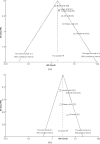Prognostic significance of SUV on PET/CT in patients with localised oesophagogastric junction cancer receiving neoadjuvant chemotherapy/chemoradiation:a systematic review and meta-analysis
- PMID: 22337686
- PMCID: PMC3487087
- DOI: 10.1259/bjr/29946900
Prognostic significance of SUV on PET/CT in patients with localised oesophagogastric junction cancer receiving neoadjuvant chemotherapy/chemoradiation:a systematic review and meta-analysis
Abstract
Objective: The objective of this study was to comprehensively review the evidence for use of pre-treatment, post-treatment and changes in tumour glucose uptake that were assessed by 18-fludeoxyglucose ((18)F-FDG) positron emission tomography (PET) early, during or immediately after neoadjuvant chemotherapy/chemoradiation to predict prognosis of localised oesophagogastric junction (AEG) cancer.
Methods: We searched for articles published in English; limited to AEG; (18)F-FDG uptake on PET performed on a dedicated device; dealt with the impact of standard uptake value (SUV) on survival. We extracted an estimate of the log hazard ratios (HRs) and their variances and performed meta-analysis.
Results: 798 patients with AEG were included. And the scan time for (18)F-FDG-PET was as follows: prior to therapy (PET1, n=646), exactly 2 weeks after initiation of neoadjuvant therapy (PET2, n=245), and pre-operatively (PET3, n=278). In the two meta-analyses for overall survival, including the studies that dealt with reduction of tumour maximum SUV (SUV(max)) (from PET1 to PET2/PET3 and from PET1 to PET2), the results were similar, with the overall HR for non-responders being 1.83 [95% confidence interval (CI), 1.41-2.36] and 2.62 (95% CI, 1.61-4.26), respectively; as for disease-free survival, the combined HR was 2.92 (95% CI, 2.08-4.10) and 2.39 (95% CI, 1.57-3.64), respectively. The meta-analyses did not attribute significant prognostic values to SUV(max) before and during therapy in localised AEG.
Conclusion: Relative changes in FDG-uptake of AEG are better prognosticators. Early metabolic changes from PET1 to PET2 may provide the same accuracy for prediction of treatment outcome as late changes from PET1 to PET3.
Figures




Similar articles
-
Prognostic utility of serial 18F-FDG-PET/CT in patients with locally advanced rectal cancer who underwent tri-modality treatment.Br J Radiol. 2020 Jan;93(1105):20190455. doi: 10.1259/bjr.20190455. Epub 2019 Oct 23. Br J Radiol. 2020. PMID: 31617737 Free PMC article.
-
Prognostic significance of SUV on PET/CT in patients with esophageal cancer: a systematic review and meta-analysis.Eur J Gastroenterol Hepatol. 2009 Sep;21(9):1008-15. doi: 10.1097/MEG.0b013e328323d6fa. Eur J Gastroenterol Hepatol. 2009. PMID: 19352191
-
The value of FDG positron emission tomography/computerised tomography (PET/CT) in pre-operative staging of colorectal cancer: a systematic review and economic evaluation.Health Technol Assess. 2011 Sep;15(35):1-192, iii-iv. doi: 10.3310/hta15350. Health Technol Assess. 2011. PMID: 21958472 Free PMC article.
-
Impact of residual disease as a prognostic factor for survival in women with advanced epithelial ovarian cancer after primary surgery.Cochrane Database Syst Rev. 2022 Sep 26;9(9):CD015048. doi: 10.1002/14651858.CD015048.pub2. Cochrane Database Syst Rev. 2022. PMID: 36161421 Free PMC article.
-
Fluorine-18-fluorodeoxyglucose (FDG) positron emission tomography (PET) computed tomography (CT) for the detection of bone, lung, and lymph node metastases in rhabdomyosarcoma.Cochrane Database Syst Rev. 2021 Nov 9;11(11):CD012325. doi: 10.1002/14651858.CD012325.pub2. Cochrane Database Syst Rev. 2021. PMID: 34753195 Free PMC article.
Cited by
-
The emerging field of radiomics in esophageal cancer: current evidence and future potential.Transl Cancer Res. 2016 Aug;5(4):410-423. doi: 10.21037/tcr.2016.06.19. Transl Cancer Res. 2016. PMID: 30687593 Free PMC article.
-
Prognostic and predictive values of interim 18F-FDG PET during neoadjuvant chemoradiotherapy for esophageal cancer: a systematic review and meta-analysis.Ann Nucl Med. 2021 Apr;35(4):447-457. doi: 10.1007/s12149-021-01583-x. Epub 2021 Jan 20. Ann Nucl Med. 2021. PMID: 33471289
-
Interim position emission tomography-computed tomography during multimodality treatment of locally advanced esophageal cancer: a scoping review.Quant Imaging Med Surg. 2023 Sep 1;13(9):6280-6295. doi: 10.21037/qims-22-1306. Epub 2023 Jul 17. Quant Imaging Med Surg. 2023. PMID: 37711778 Free PMC article.
-
Current Role of Artificial Intelligence in the Management of Esophageal Cancer.J Clin Med. 2025 Mar 9;14(6):1845. doi: 10.3390/jcm14061845. J Clin Med. 2025. PMID: 40142652 Free PMC article. Review.
-
Early Metabolic Change after Induction Chemotherapy Predicts Histologic Response and Prognosis in Patients with Esophageal Cancer: Secondary Analysis of a Randomized Trial.Target Oncol. 2018 Feb;13(1):99-106. doi: 10.1007/s11523-017-0540-3. Target Oncol. 2018. PMID: 29218623 Free PMC article. Clinical Trial.
References
-
- Sawyers CL. The cancer biomarker problem. Nature 2008;452:548–52 - PubMed
-
- van't Veer LJ, Bernards R. Enabling personalized cancer medicine through analysis of gene-expression patterns. Nature 2008;452:564–70 - PubMed
-
- Luthra MG, Ajani JA, Izzo J, Ensor J, Wu TT, Rashid A, et al. Decreased expression of gene cluster at chromosome 1q21 defines molecular subgroups of chemoradiotherapy response in esophageal cancers. Clin Cancer Res 2007;13:912–19 - PubMed
-
- Luthra R, Wu TT, Luthra MG, Izzo J, Lopez-Alvarez E, Zhang L, et al. Gene expression profiling of localized esophageal carcinomas: association with pathologic response to preoperative chemoradiation. J Clin Oncol 2006;24:259–67 - PubMed

